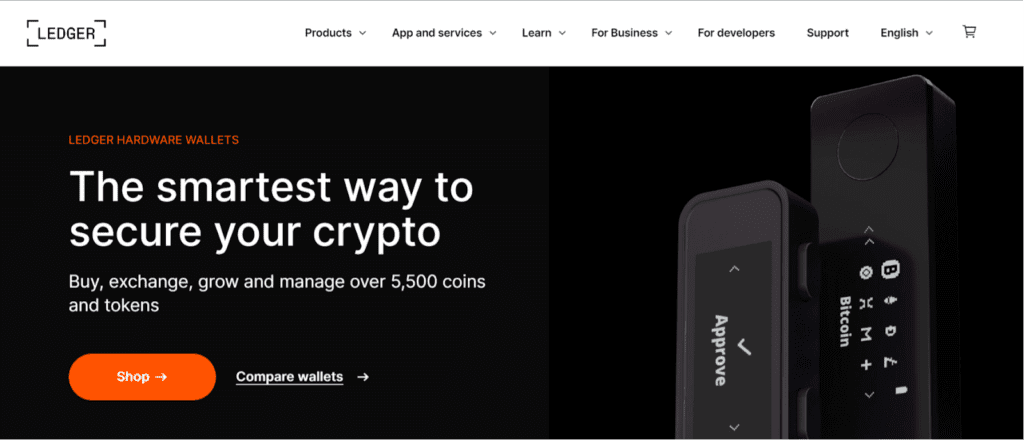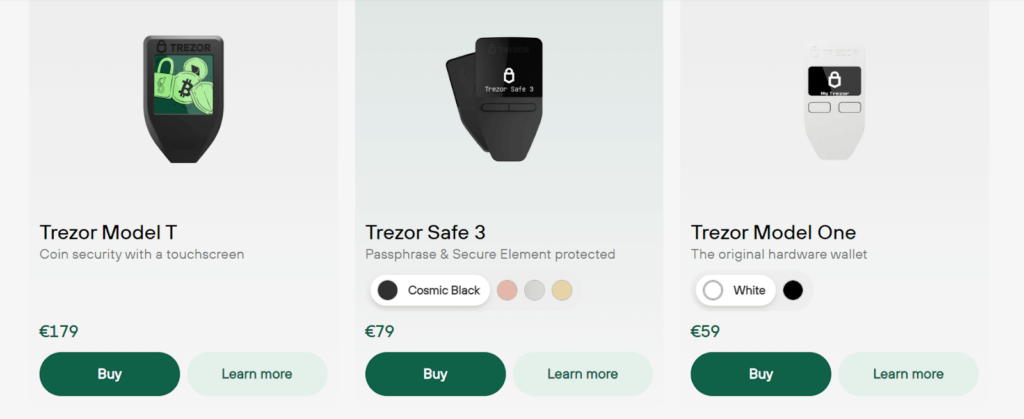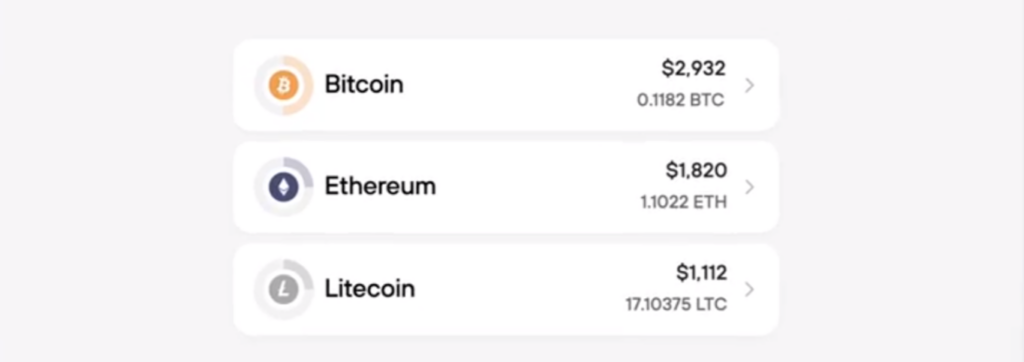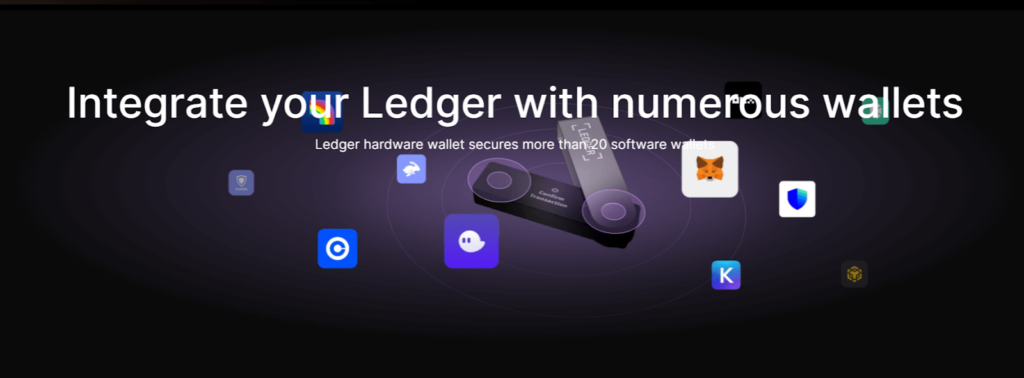Choosing the perfect hardware wallet to store your cryptocurrency is difficult, as Ledger and Trezor are two strong names. They both have remarkable features and security. But how do they work, store 1000s of currencies, and which of them should you choose?
With over 10 years of experience reviewing Web3 products, we will compare Ledger and Trezor, highlighting their features, pricing, and ease of use. We will also explore their models and security framework.
Key Differences Summary
| Features | Ledger Wallet | Trezor Wallet |
|---|---|---|
| Type of Wallet | Physical wallet, cold storage | Physical wallet, cold storage |
| Available Models | Ledger Nano S Plus, Nano X, and Stax | Trezor Model One, Trezor Model T, and Trezor Safe 3 |
| Cost Price of Wallet | $79 – $279 | $69 – $219 |
| Supported Coins | Over 6,000+ crypto assets | 8000+ supported crypto assets |
| Incorporated Exchanges | Yes | Yes |
| Size and Dimension | Nano S Plus: 21g; 62 mm x 17 mm x 11 mm Nano X: 34g; 72mm x 18mm x 11 mm Stax: 45.2g; 85mm x 54mm x 6mm | Trezor Model One: 12g; 60mm x 30mm x 10mm Trezor Safe 3: 14g; 59mm x 32mm x 7.4mm Trezor Model T: 22g; 64mm x 39mm x 10mm |
| Mobile App | Yes, Android and iOS | Trezor Suite Light for Android |
Overview of Ledger Wallet

What are the main features? A ledger is a multi-functional wallet used to safely store digital assets. All models are compatible with the Ledger Live App and other third-party wallets and exchanges. Ledger Stax has the most advanced features compared to others.
Available models: There are three main Ledger models: the Ledger Nano S Plus, Ledger Nano X, and Ledger Stax.
What are the purchase prices of these Ledger devices? The Ledger Nano S Plus is $79, the Ledger Nano X is $149, and the Ledger Stax is $279.
How many crypto assets are supported on Ledger? All Ledger wallet models support over 5,000 digital assets with additional support for third-party exchanges and NFTs.
What is the security framework? Besides being a cold wallet that gives investors control of their private keys, other security features include a PIN code, recovery phrase, and secure element.
Pros:
- Most secure hardware wallet.
- Allows users to hold cryptocurrencies and NFTs.
- The Nano X and Stax models have advanced wireless charging and Bluetooth connection features.
Cons:
- The Nano S Plus has limited storage
- The Stax model is expensive.
More details
The Ledger Nano X is a must-have, secure hardware wallet for cryptocurrency. It features easy mobile pairing, a sleek design, Bluetooth support, and robust security features like a safe chip and two-factor authentication.
-
Supports 5500 various cryptocurrencies.
-
Private keys are encrypted.
-
Desktop and mobile devices are supported.
-
Bluetooth enabled.
-
Allow 100 apps storage.
-
Fairly overpriced against the competition.
-
Only 100 apps are allowed.
-
Bluetooth works solely with mobile.
Overview of Trezor Wallet

What are the main features? Trezor is a dynamic hardware wallet with multi-faceted features that allow users to send, receive, and trade crypto assets. While Trezor Model T has a touchscreen, Safe 3 and Model One use Two-button pads.
Available Trezor Models: Trezor Model T, Trezor Model One, and Safe 3 are the available designs.
What are the cost prices of Trezor models? The prices vary based on the features of each model. Trezor One – $69; Safe 3 – $79; Model T – $219.
Supported crypto assets: Between 8,000+ crypto assets are supported on all Trezor models.
What are the sizes and dimensions of Trezor models? The weight and dimensions of each Trezor model include Trezor Model One: 12g; 60mm x 30mm x 10mm; Trezor Model T: 22g; 64mm x 39mm x 10mm.
Pros:
- Users can hold and trade over 1,400 digital assets.
- The T model has a colored screen, which improves the physical appearance
- Trezor Model One and Model T are more affordable than Nano X and Stax.
Cons:
- Bluetooth connectivity and wireless charging are not enabled in Trezor.


More details
The Trezor Model T is a high-quality hardware wallet that offers top-notch security for cryptocurrency investors. Trezor is known for its transparency and trustworthiness. The ability to store 1500+ tokens and Non-Fungible Tokens (NFTs) justifies the premium price of $219. However, some users have reported issues with the MicroSD card slot. Trezor Model T is a solid pick to safeguard crypto despite minor concerns.
-
It supports 1400+ crypto assets.
-
Touch screen for a user-friendly operation.
-
It supports NFTs storage.
-
Too expensive when compared to its competitors.
-
It has limited mobile compatibility.
-
A bulky design that is quite hard to carry around.
Ledger vs Trezor: Company Overview
Both companies are unique in competing to provide the best hardware crypto wallets. While Trezor was launched in 2013 under SatoshiLabs in Prague, Czech Republic, Ledger was founded in Paris, France, a year later (2014).
Ledger vs Trezor: Features
Both Ledger and Trezor have similar features. While Ledger devices are sleek and closely resemble steel USB storage devices (except for Stax), Trezor devices are lighter and enclosed in a plastic casing.
All Ledger and Trezor devices are compatible with desktop devices such as Windows, Linux, and MacOS and can be connected via USB cables. While all ledger models are compatible with Android and iOS devices, Trezor users can leverage the Trezor Suite Lite and connect to Android devices in mobile browsers. Ledger Nano X and Stax models have excellent Bluetooth connectivity, which Trezor lacks.
Ledger vs Trezor: Available Models
Both Ledger and Trezor have three different models, respectively.
Trezor is known for the following models:
- Model One
- Model T
- Safe 3
Ledger is popular for the following models:
- Nano S Plus
- Nano X
- Ledger Stax models

Trezor Model One and Ledger Nano S Plus are the pioneer versions of both wallets. Even though they are quite affordable and support many digital assets, they lack some basic physical features in the advanced models. For instance, the Trezor Model T and Nano Stax are both touchscreen devices, while the Nano S, Plus, and Trezor One have static screens.
Ledger vs Trezor: Cost and Fees
| Ledger Models | Prices | Trezor Models | Prices |
|---|---|---|---|
| Nano S Plus | $79 | Model One | $69 |
| Nano X | $149 | Safe 3 | $79 |
| Stax | $279 | Model T | $219 |
The prices of each Ledger or Trezor model largely depend on their features. Ledger Stax and Trezor T are more advanced than Nano S Plus and Trezor One, making them more expensive.
The premium versions of both Ledger and Trezor are similar because they present a touchscreen. However, Stax costs $279, has a large gray screen, and supports Bluetooth connectivity, while Trezor T has a smaller colored screen and costs $217.
Ledger vs Trezor: Wallets and Supported Coins
Both Ledger and Trezor support a good number of crypto assets. While Ledger supports over 5000, Trezor supports between 1280 and 1456.
All Ledger models support the same coins and tokens, such as:
- Bitcoin
- Ethereum
- Binance
- Tether
- Monero
- Stellar
- Ripple
- Dogecoin
- Cardano
- Polkadot.
Trezor One supports fewer coins than Model T. The supported coins include:
- Bitcoin
- Dogecoin
- Ethereum
- USD Coin (USDC)
- Litecoin
- Polygon (MATIC)

Both wallets generally support diverse virtual assets, including those from third-party wallets and exchanges. However, it is crucial to note that Trezor does not support certain coins such as Cardano (ADA), Ripple (XRP), Tezos (XTZ), Binance Coin (BNB), Eos, and Monero (XRM).
Ledger vs Trezor: Security
Trezor and Ledger wallets have full-bodied security, and users can control their private keys.
Both wallets use password systems. However, the Ledger device has a secure element chip that gives it an extra layer of security. Unlike Trezor’s open-source hardware wallets, Ledger has a closed-source architecture that prevents developers from reviewing its code for vulnerabilities.
It’s critical to note that Ledger experienced a marketing database breach in 2020. Another exploit occurred in December 2023, where an attacker injected a drainer in Ledger’s Connection Kit (a software component). However, the Ledger Live software and its central software remain intact.
Ledger vs Trezor: Ease of Use
Both hardware wallets, which present a friendly user interface, can be set up easily. While Trezor T and Stax have a touchscreen design, other older models have two physical buttons that can be used to navigate the device.
The Ledger Nano X model is slightly bigger than the S Plus. Trezor T has a colored screen but is smaller than the Stax. The large screen on Stax is beneficial for easy viewing and navigation.
Additionally, all Trezor and Ledger models are compatible with desktop devices and can be connected via USB cables. However, only Ledger wallets support Bluetooth connection.
Trezor vs Ledger: Mobile Devices
Both hardware wallets are compatible with mobile devices to help users trade and access their coins on the go. While Trezor wallets support only Android devices, Ledger wallets have Android and iOS mobile apps. This makes it easier for crypto users to connect the physical device to their smartphones to access the Ledger Live mobile app.

Trezor vs Ledger: Customer Support
While both hardware wallets have great customer support systems, Trezor Wallet prioritizes its knowledge base page and live chat, often redirecting customers who need support there. On the other hand, Ledger provides users with an FAQ page, email address, and live chat for easy reach.
New and experienced investors can use the Ledger Academy to gain more resources on how the hardware wallet works. Trezor wallet users can also access the platform’s community to share ideas and interact with other members.
Ledger vs Trezor: Integrations
Besides ranking as the best crypto hardware wallets, both Ledger and Trezor are unique based on their third-party integrations. These crypto wallets support several built-in exchanges and crypto wallets, hence the thousands of coins available on their platforms.

Trezor is open-source, making integrating third-party software and exchanging crypto easier. With Ledger having closed-source software, third-party companies can only easily integrate their products if they contact the company first.
Trezor vs Ledger: Functional Tools
Ledger and Trezor are unique wallets with beginner—to advanced-level tools that enhance security and self-custody. They allow you to take ownership of your private keys. The Ledger Live feature allows you to trade cryptocurrency and track the market.
Trezor’s devices (touchscreen and physical buttons) and streamlined software interface, Trezor Suite, make it easy for new and experienced investors to use.
Trezor vs Ledger: Staking Options
Trezor and Ledger are some of the best wallets for staking. While staking on exchanges attracts additional fees, it is free on hardware wallets. Ledger supports staking a wide range of cryptocurrencies, such as Ethereum (ETH), Tron (TRON), Cardano (ADA), Cosmos (ATOM), Algorand (ALGO), Neo (NEO), Tezos (XTZ), and Cronos.
Trezor, on the other hand, has fewer staking options than Algorand, Solana, Cosmos, Vechain, Tezos, and others.
How to set It up
Setting up your Ledger and Trezor devices can be done in a few steps.
Set up your Ledger device:
- Open the Ledger Live app on your mobile or desktop and connect your device using a USB cable or Bluetooth connection.
- Follow the instructions to set up a new device or restore an old one. Proceed to set a PIN code to lock your device.
- Copy your recovery phrase onto a sheet of paper and store it safely.
- Installing the applications and apps for the crypto assets you want on your device using the Ledger Live app.
- Add your account to Ledger Live to manage and track your crypto assets.
Set up your Trezor device:
- Visit Trevor.io on your website browser.
- Select your Trezor model and install the firmware by following the instructions outlined.
- Proceed to set up a new wallet or recover an old one.
- Copy your mnemonic phrase on a piece of paper and keep it safe.
- Set a PIN code and name your device for extra security.
- Get the Trazor suite and other apps to use with your wallet.
Final Verdict
Ledger and Trezor are considered the best two hardware wallets in the market. They provide a user-friendly platform for effective crypto storage. Although picking the best hardware wallet can be dicey due to individual preference, Ledger takes the lead.
Why Coinweb chose Ledger: Ledger is the winner because it has a larger touchscreen, works on Android and iOS devices, and supports more coins than Trezor, making it worth the price.
Yes, both Ledger and Trezor wallets can be hacked but not as easy as hot wallets or software wallets. The wallet can be hacked through phishing, manipulation of software codes, and private data breaches.
Trezor is considered safer because it has open-source software that developers can audit for vulnerabilities.
The major advantage Ledger Nano X has over Trezor is its Bluetooth connection and support for more cryptocurrencies.
Ledger is more expensive than Trezor wallets. For instance, Ledger’s Stax costs $279 while Trezor model T costs $219.
Both are good. Investors who want to trade more coins and have access to their wallets on both Android and iOS devices will find Ledger useful.











